LINCOLN MARK VIII 1998 Owners Manual
Manufacturer: LINCOLN, Model Year: 1998, Model line: MARK VIII, Model: LINCOLN MARK VIII 1998Pages: 170, PDF Size: 1.37 MB
Page 151 of 170
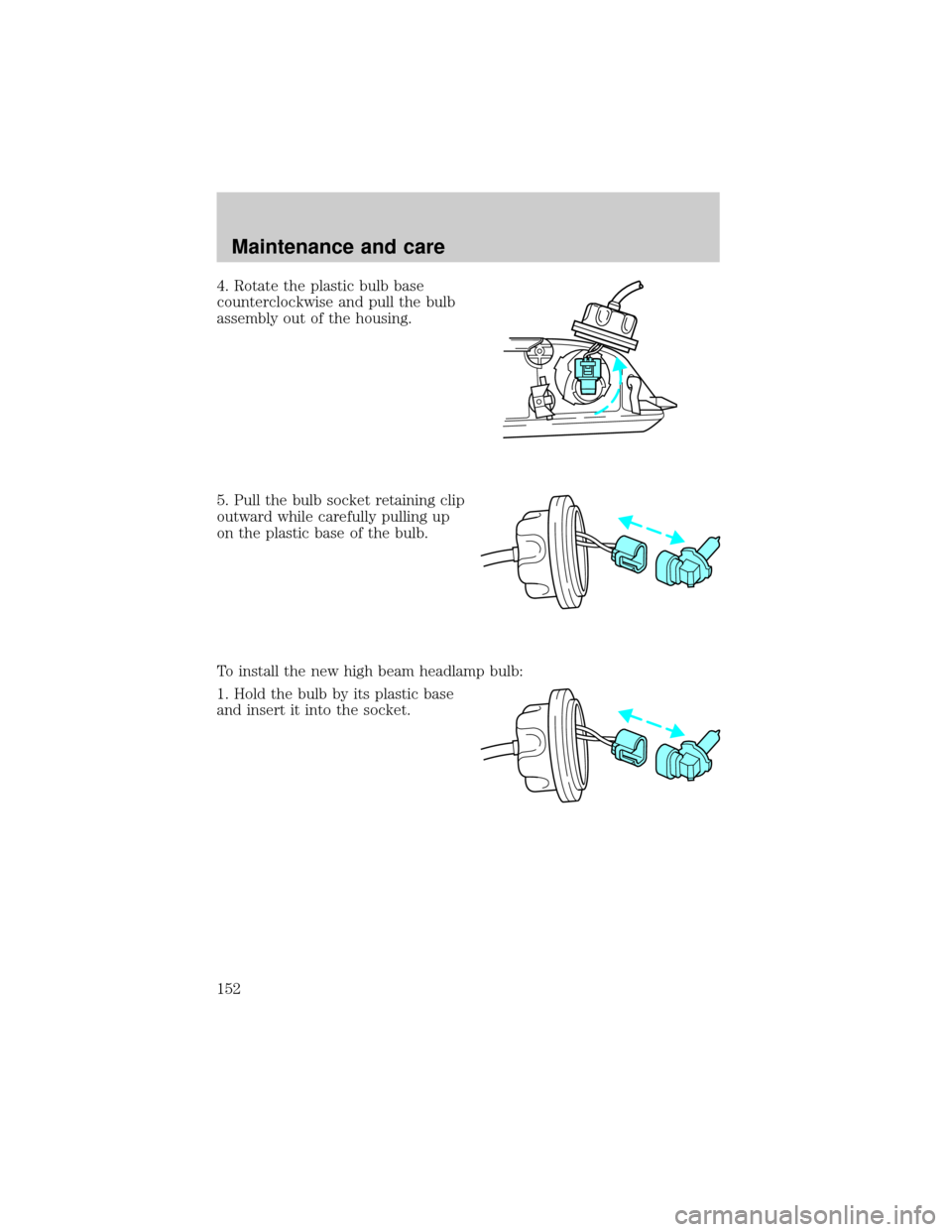
4. Rotate the plastic bulb base
counterclockwise and pull the bulb
assembly out of the housing.
5. Pull the bulb socket retaining clip
outward while carefully pulling up
on the plastic base of the bulb.
To install the new high beam headlamp bulb:
1. Hold the bulb by its plastic base
and insert it into the socket.
Maintenance and care
152
Page 152 of 170
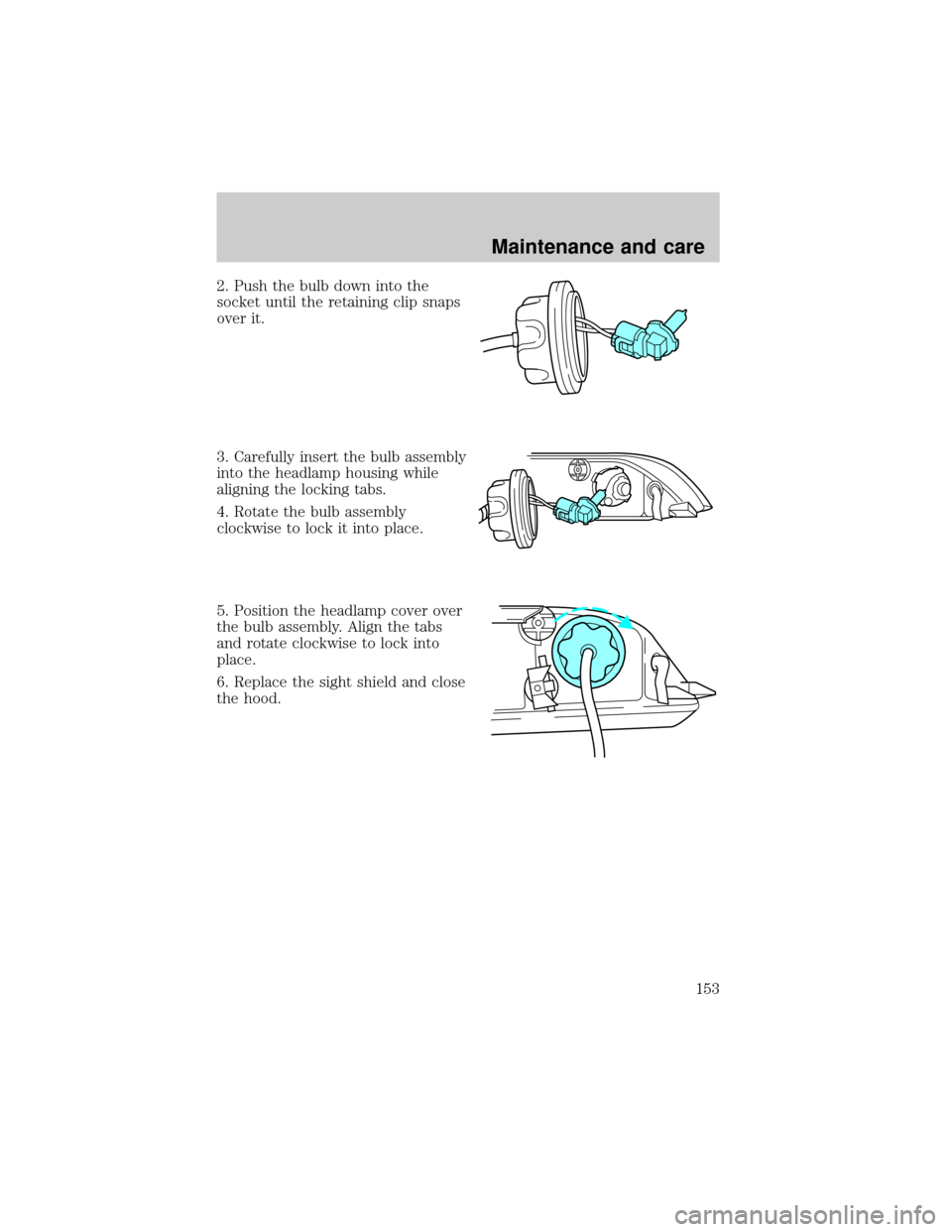
2. Push the bulb down into the
socket until the retaining clip snaps
over it.
3. Carefully insert the bulb assembly
into the headlamp housing while
aligning the locking tabs.
4. Rotate the bulb assembly
clockwise to lock it into place.
5. Position the headlamp cover over
the bulb assembly. Align the tabs
and rotate clockwise to lock into
place.
6. Replace the sight shield and close
the hood.
Maintenance and care
153
Page 153 of 170
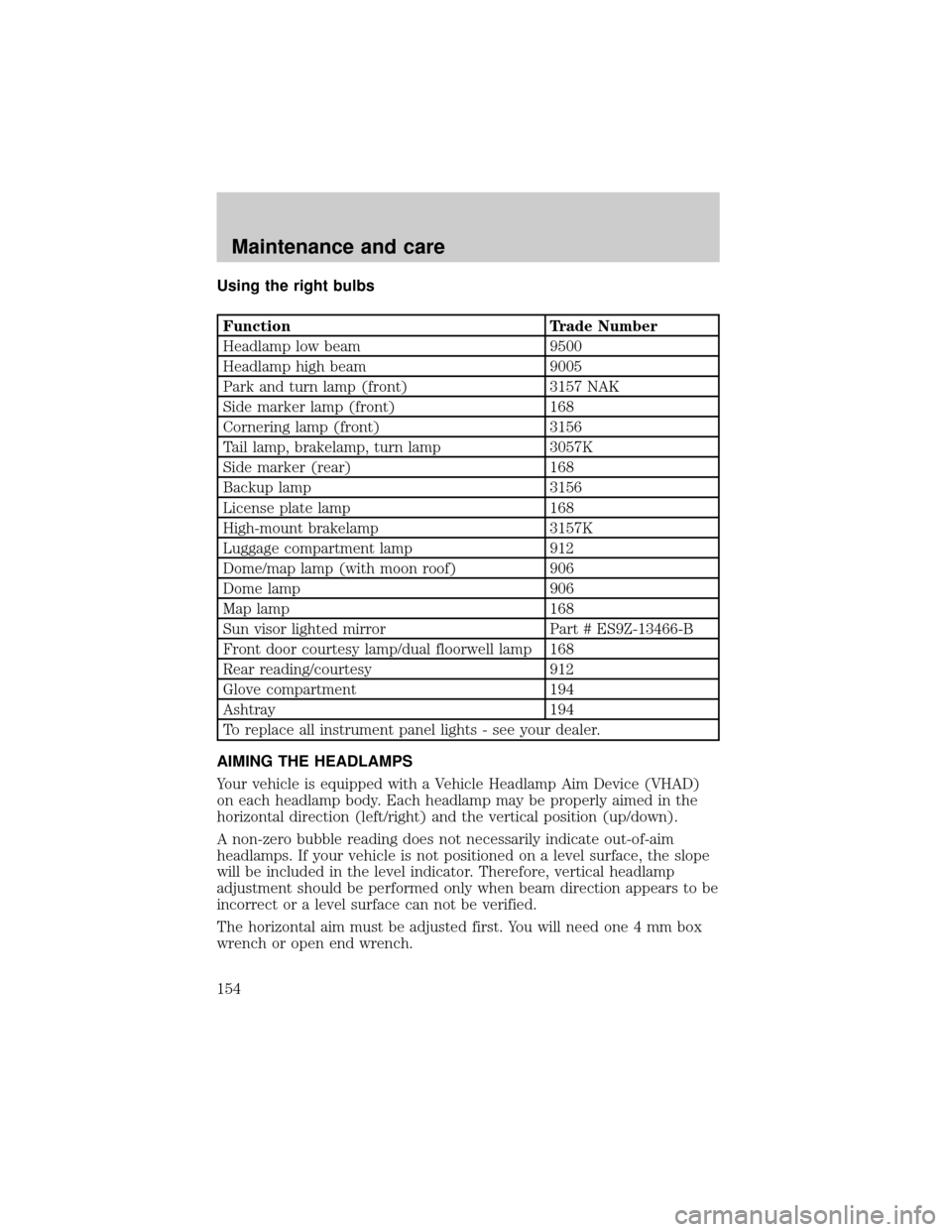
Using the right bulbs
Function Trade Number
Headlamp low beam 9500
Headlamp high beam 9005
Park and turn lamp (front) 3157 NAK
Side marker lamp (front) 168
Cornering lamp (front) 3156
Tail lamp, brakelamp, turn lamp 3057K
Side marker (rear) 168
Backup lamp 3156
License plate lamp 168
High-mount brakelamp 3157K
Luggage compartment lamp 912
Dome/map lamp (with moon roof) 906
Dome lamp 906
Map lamp 168
Sun visor lighted mirror Part # ES9Z-13466-B
Front door courtesy lamp/dual floorwell lamp 168
Rear reading/courtesy 912
Glove compartment 194
Ashtray 194
To replace all instrument panel lights - see your dealer.
AIMING THE HEADLAMPS
Your vehicle is equipped with a Vehicle Headlamp Aim Device (VHAD)
on each headlamp body. Each headlamp may be properly aimed in the
horizontal direction (left/right) and the vertical position (up/down).
A non-zero bubble reading does not necessarily indicate out-of-aim
headlamps. If your vehicle is not positioned on a level surface, the slope
will be included in the level indicator. Therefore, vertical headlamp
adjustment should be performed only when beam direction appears to be
incorrect or a level surface can not be verified.
The horizontal aim must be adjusted first. You will need one 4 mm box
wrench or open end wrench.
Maintenance and care
154
Page 154 of 170
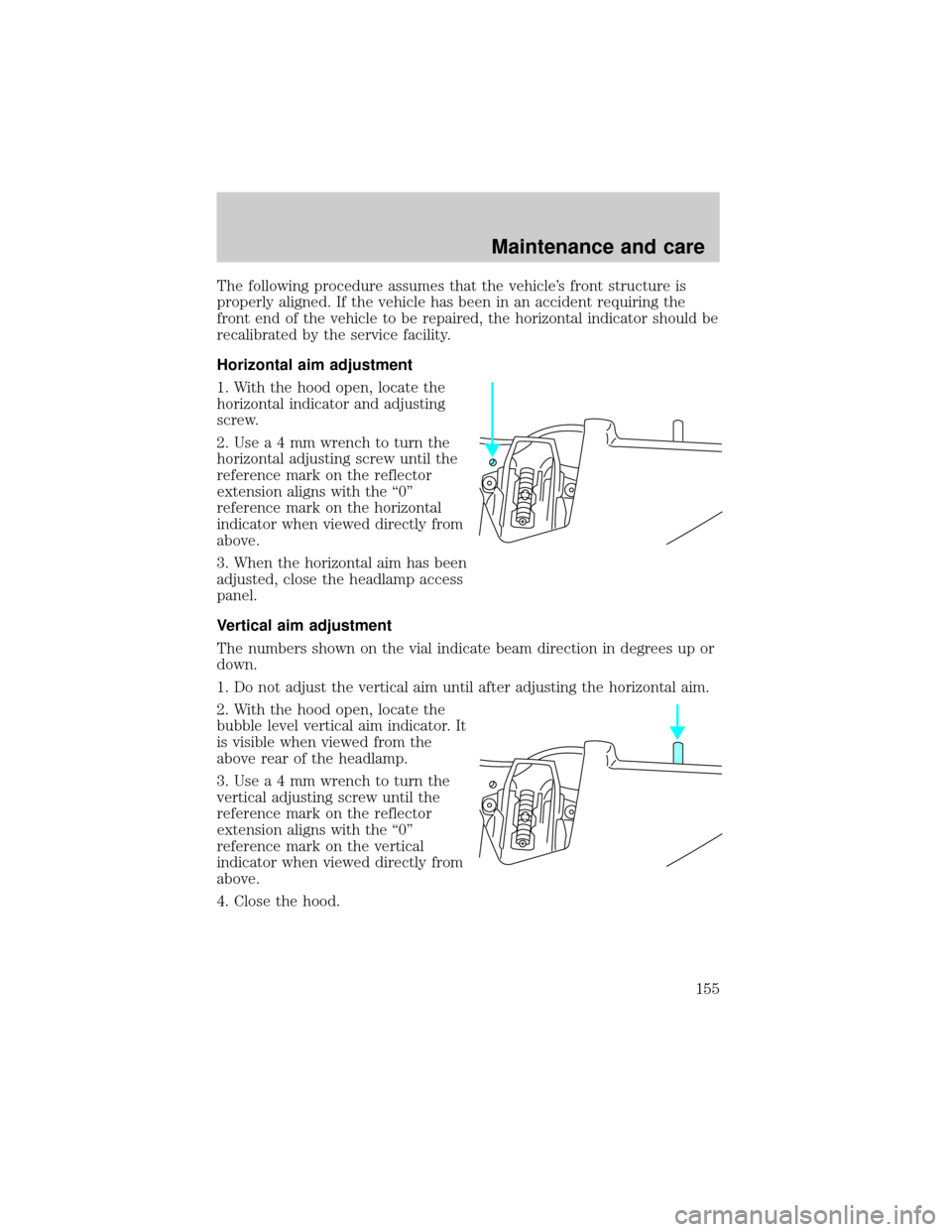
The following procedure assumes that the vehicle's front structure is
properly aligned. If the vehicle has been in an accident requiring the
front end of the vehicle to be repaired, the horizontal indicator should be
recalibrated by the service facility.
Horizontal aim adjustment
1. With the hood open, locate the
horizontal indicator and adjusting
screw.
2.Usea4mmwrench to turn the
horizontal adjusting screw until the
reference mark on the reflector
extension aligns with the ª0º
reference mark on the horizontal
indicator when viewed directly from
above.
3. When the horizontal aim has been
adjusted, close the headlamp access
panel.
Vertical aim adjustment
The numbers shown on the vial indicate beam direction in degrees up or
down.
1. Do not adjust the vertical aim until after adjusting the horizontal aim.
2. With the hood open, locate the
bubble level vertical aim indicator. It
is visible when viewed from the
above rear of the headlamp.
3.Usea4mmwrench to turn the
vertical adjusting screw until the
reference mark on the reflector
extension aligns with the ª0º
reference mark on the vertical
indicator when viewed directly from
above.
4. Close the hood.
Maintenance and care
155
Page 155 of 170
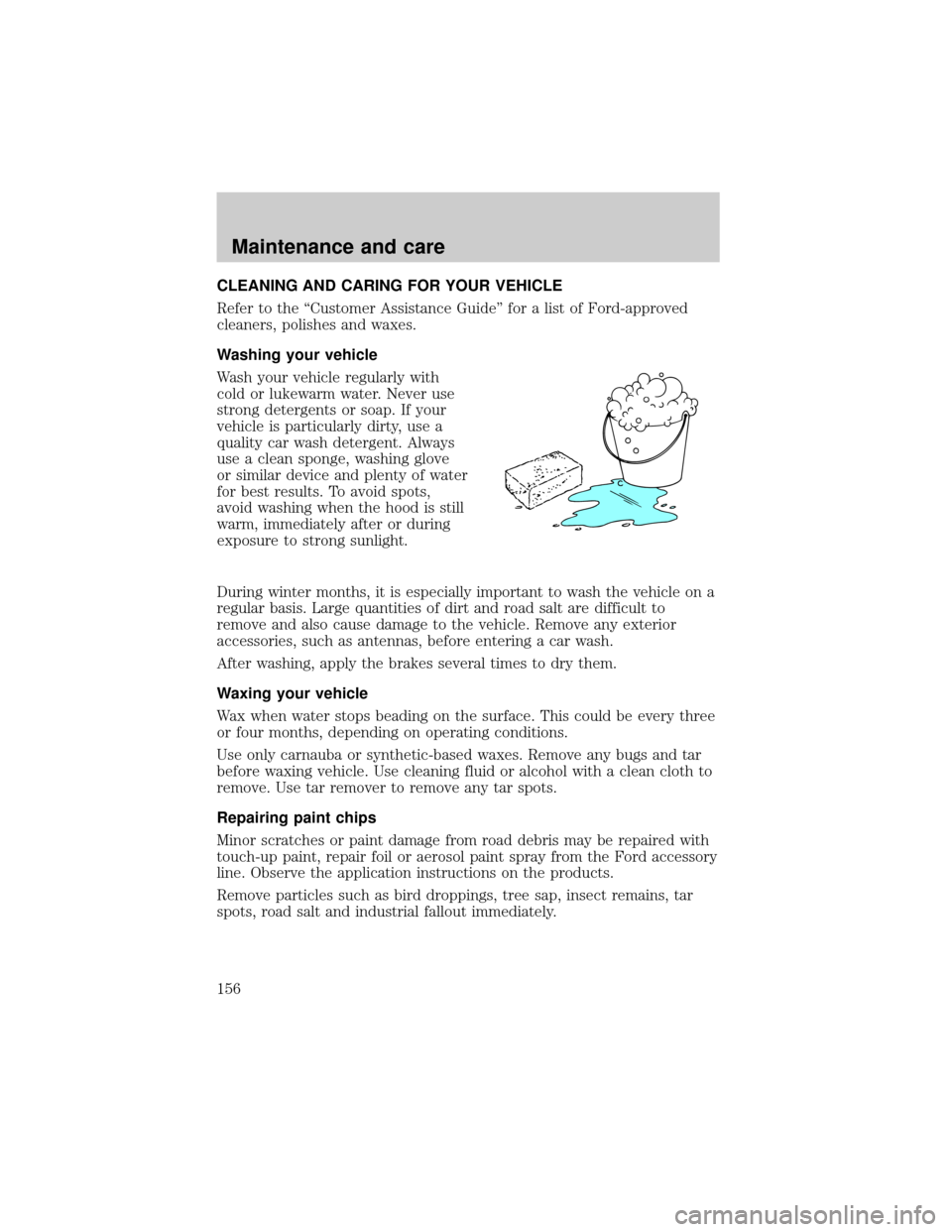
CLEANING AND CARING FOR YOUR VEHICLE
Refer to the ªCustomer Assistance Guideº for a list of Ford-approved
cleaners, polishes and waxes.
Washing your vehicle
Wash your vehicle regularly with
cold or lukewarm water. Never use
strong detergents or soap. If your
vehicle is particularly dirty, use a
quality car wash detergent. Always
use a clean sponge, washing glove
or similar device and plenty of water
for best results. To avoid spots,
avoid washing when the hood is still
warm, immediately after or during
exposure to strong sunlight.
During winter months, it is especially important to wash the vehicle on a
regular basis. Large quantities of dirt and road salt are difficult to
remove and also cause damage to the vehicle. Remove any exterior
accessories, such as antennas, before entering a car wash.
After washing, apply the brakes several times to dry them.
Waxing your vehicle
Wax when water stops beading on the surface. This could be every three
or four months, depending on operating conditions.
Use only carnauba or synthetic-based waxes. Remove any bugs and tar
before waxing vehicle. Use cleaning fluid or alcohol with a clean cloth to
remove. Use tar remover to remove any tar spots.
Repairing paint chips
Minor scratches or paint damage from road debris may be repaired with
touch-up paint, repair foil or aerosol paint spray from the Ford accessory
line. Observe the application instructions on the products.
Remove particles such as bird droppings, tree sap, insect remains, tar
spots, road salt and industrial fallout immediately.
Maintenance and care
156
Page 156 of 170

Cleaning the wheels
Wash with the same detergent as the body of your vehicle. Do not use
acid-based wheel cleaners, steel wool, fuel or strong detergents. Never
use abrasives that will damage the finish of special wheel surfaces. Use a
tar remover to remove grease and tar.
Cleaning the engine
Engines are more efficient when they are clean because grease and dirt
buildup keep the engine warmer than normal. When washing:
²Take care when using a power washer to clean the engine. The high
pressure fluid could penetrate the sealed parts and cause damage.
²Do not spray with cold water to avoid cracking the engine block or
other engine components.
²Cover the highlighted areas to prevent water damage when cleaning
the engine.
²Never wash or rinse the engine while it is running; water in the
running engine may cause internal damage.
Maintenance and care
157
Page 157 of 170
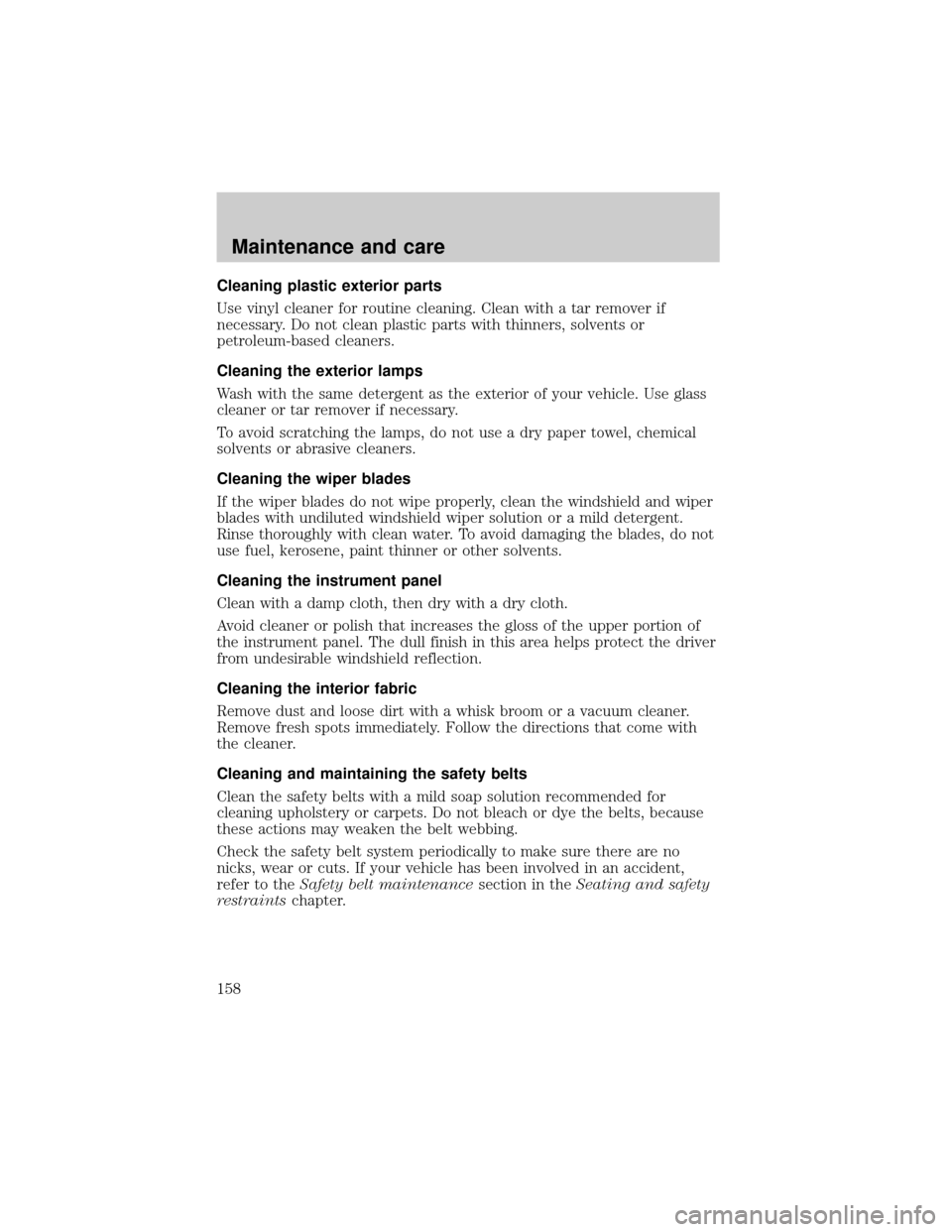
Cleaning plastic exterior parts
Use vinyl cleaner for routine cleaning. Clean with a tar remover if
necessary. Do not clean plastic parts with thinners, solvents or
petroleum-based cleaners.
Cleaning the exterior lamps
Wash with the same detergent as the exterior of your vehicle. Use glass
cleaner or tar remover if necessary.
To avoid scratching the lamps, do not use a dry paper towel, chemical
solvents or abrasive cleaners.
Cleaning the wiper blades
If the wiper blades do not wipe properly, clean the windshield and wiper
blades with undiluted windshield wiper solution or a mild detergent.
Rinse thoroughly with clean water. To avoid damaging the blades, do not
use fuel, kerosene, paint thinner or other solvents.
Cleaning the instrument panel
Clean with a damp cloth, then dry with a dry cloth.
Avoid cleaner or polish that increases the gloss of the upper portion of
the instrument panel. The dull finish in this area helps protect the driver
from undesirable windshield reflection.
Cleaning the interior fabric
Remove dust and loose dirt with a whisk broom or a vacuum cleaner.
Remove fresh spots immediately. Follow the directions that come with
the cleaner.
Cleaning and maintaining the safety belts
Clean the safety belts with a mild soap solution recommended for
cleaning upholstery or carpets. Do not bleach or dye the belts, because
these actions may weaken the belt webbing.
Check the safety belt system periodically to make sure there are no
nicks, wear or cuts. If your vehicle has been involved in an accident,
refer to theSafety belt maintenancesection in theSeating and safety
restraintschapter.
Maintenance and care
158
Page 158 of 170
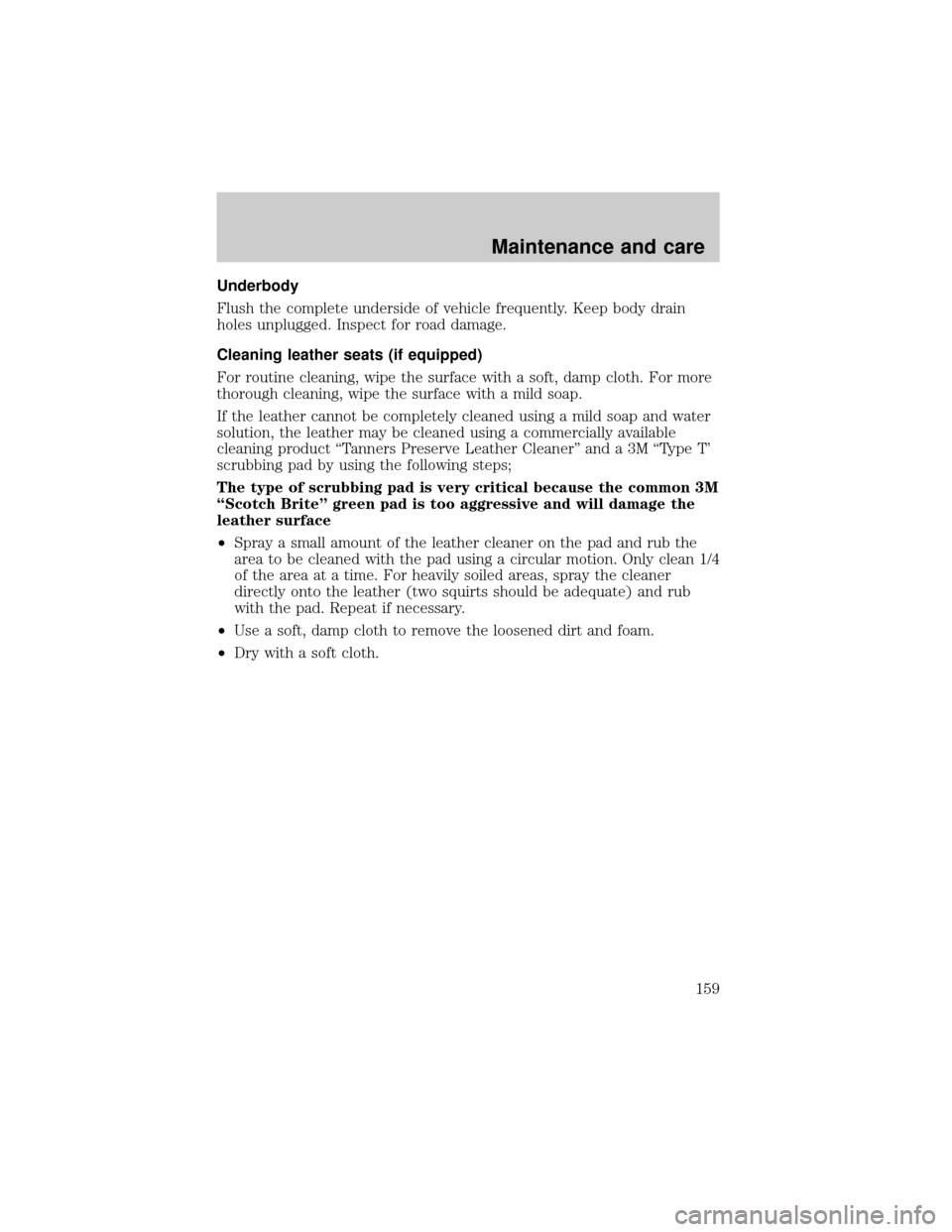
Underbody
Flush the complete underside of vehicle frequently. Keep body drain
holes unplugged. Inspect for road damage.
Cleaning leather seats (if equipped)
For routine cleaning, wipe the surface with a soft, damp cloth. For more
thorough cleaning, wipe the surface with a mild soap.
If the leather cannot be completely cleaned using a mild soap and water
solution, the leather may be cleaned using a commercially available
cleaning product ªTanners Preserve Leather Cleanerº and a 3M ªType T'
scrubbing pad by using the following steps;
The type of scrubbing pad is very critical because the common 3M
ªScotch Briteº green pad is too aggressive and will damage the
leather surface
²Spray a small amount of the leather cleaner on the pad and rub the
area to be cleaned with the pad using a circular motion. Only clean 1/4
of the area at a time. For heavily soiled areas, spray the cleaner
directly onto the leather (two squirts should be adequate) and rub
with the pad. Repeat if necessary.
²Use a soft, damp cloth to remove the loosened dirt and foam.
²Dry with a soft cloth.
Maintenance and care
159
Page 159 of 170
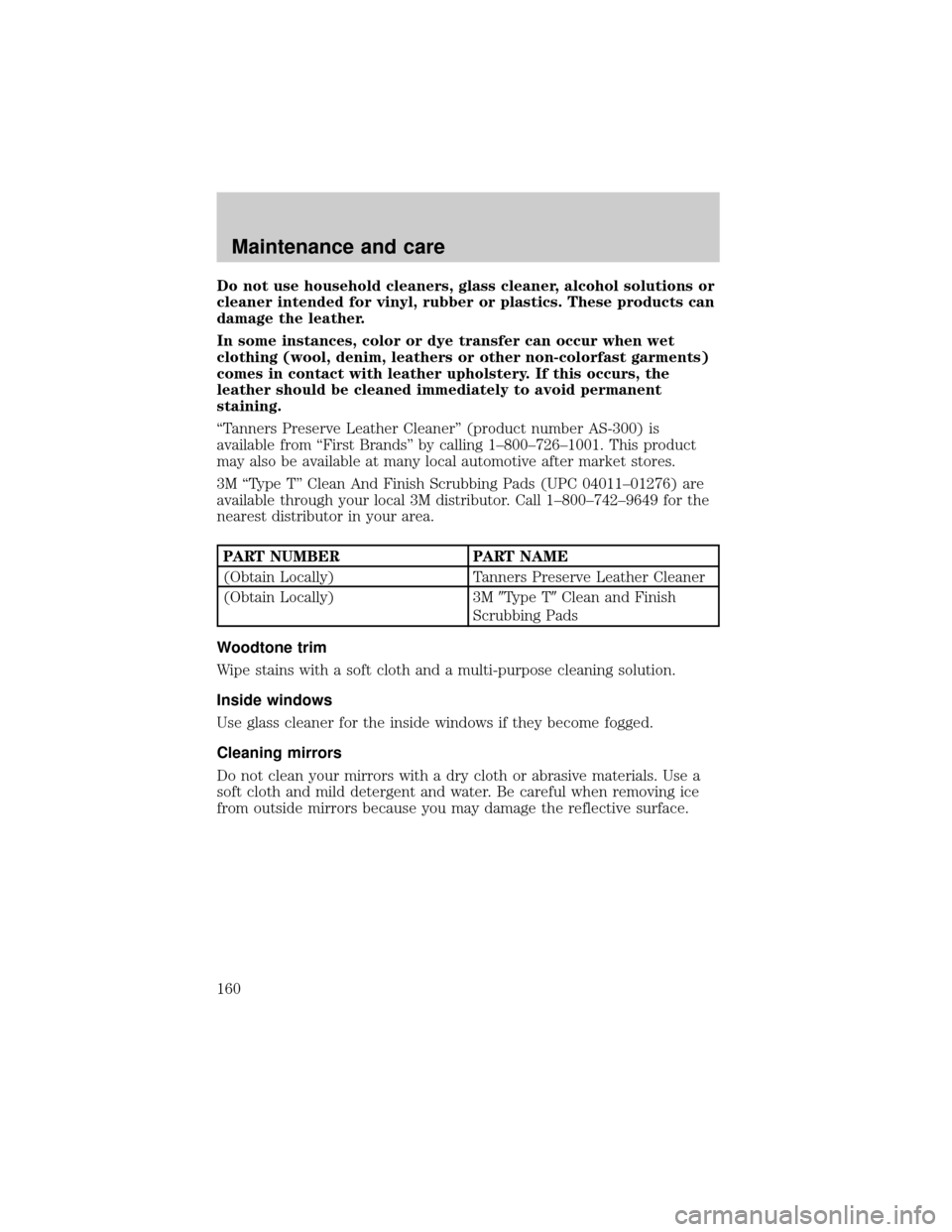
Do not use household cleaners, glass cleaner, alcohol solutions or
cleaner intended for vinyl, rubber or plastics. These products can
damage the leather.
In some instances, color or dye transfer can occur when wet
clothing (wool, denim, leathers or other non-colorfast garments)
comes in contact with leather upholstery. If this occurs, the
leather should be cleaned immediately to avoid permanent
staining.
ªTanners Preserve Leather Cleanerº (product number AS-300) is
available from ªFirst Brandsº by calling 1±800±726±1001. This product
may also be available at many local automotive after market stores.
3M ªType Tº Clean And Finish Scrubbing Pads (UPC 04011±01276) are
available through your local 3M distributor. Call 1±800±742±9649 for the
nearest distributor in your area.
PART NUMBER PART NAME
(Obtain Locally) Tanners Preserve Leather Cleaner
(Obtain Locally) 3M9Type T9Clean and Finish
Scrubbing Pads
Woodtone trim
Wipe stains with a soft cloth and a multi-purpose cleaning solution.
Inside windows
Use glass cleaner for the inside windows if they become fogged.
Cleaning mirrors
Do not clean your mirrors with a dry cloth or abrasive materials. Use a
soft cloth and mild detergent and water. Be careful when removing ice
from outside mirrors because you may damage the reflective surface.
Maintenance and care
160
Page 160 of 170
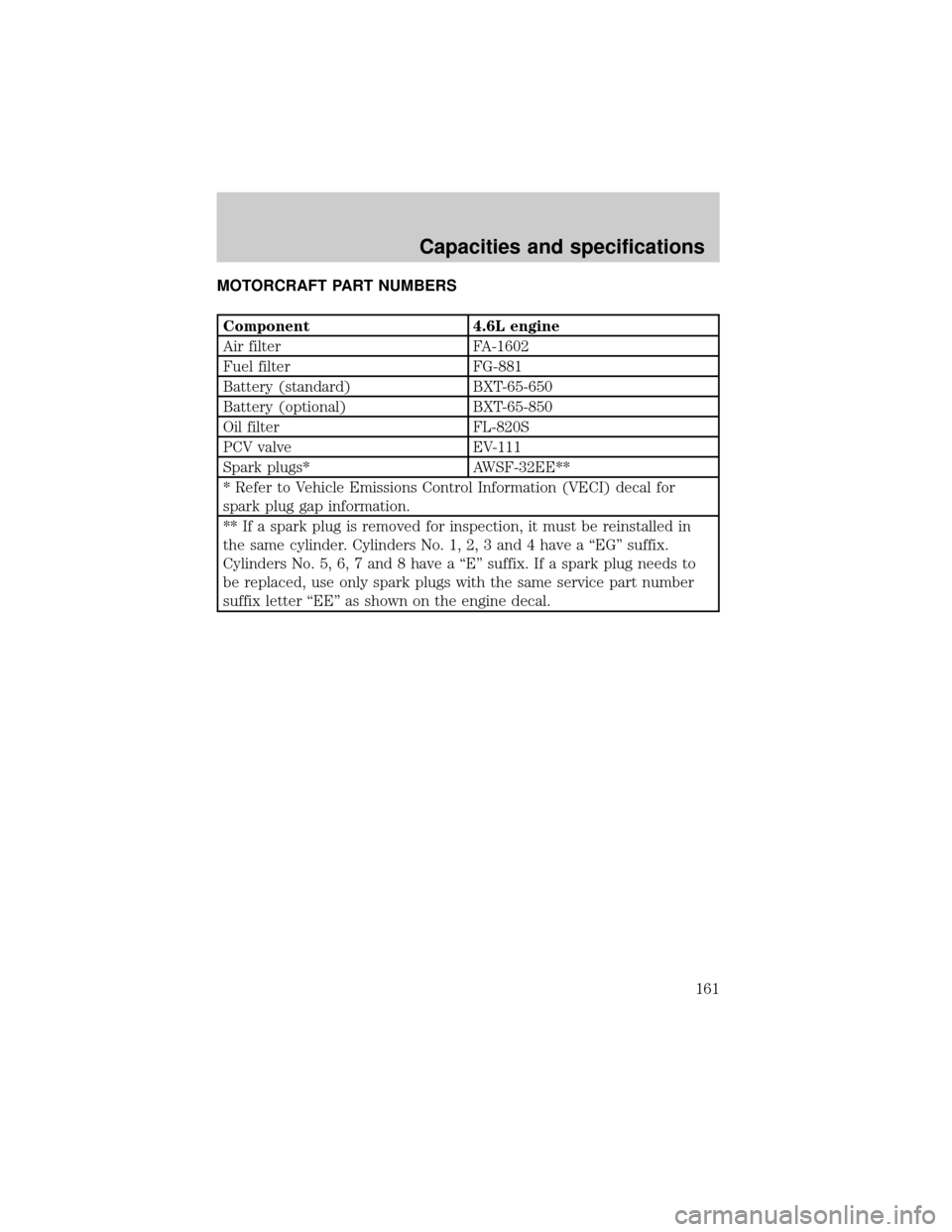
MOTORCRAFT PART NUMBERS
Component 4.6L engine
Air filter FA-1602
Fuel filter FG-881
Battery (standard) BXT-65-650
Battery (optional) BXT-65-850
Oil filter FL-820S
PCV valve EV-111
Spark plugs* AWSF-32EE**
* Refer to Vehicle Emissions Control Information (VECI) decal for
spark plug gap information.
** If a spark plug is removed for inspection, it must be reinstalled in
the same cylinder. Cylinders No. 1, 2, 3 and 4 have a ªEGº suffix.
Cylinders No. 5, 6, 7 and 8 have a ªEº suffix. If a spark plug needs to
be replaced, use only spark plugs with the same service part number
suffix letter ªEEº as shown on the engine decal.
Capacities and specifications
161